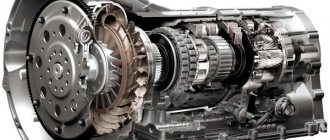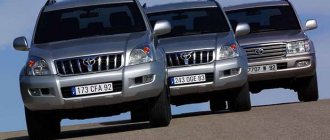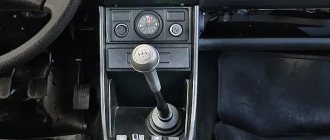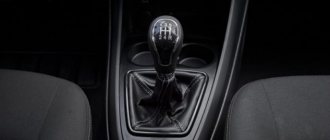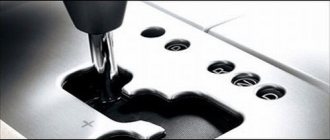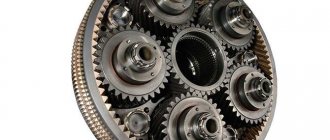Today, many novice drivers, and even experienced car enthusiasts, choose a car with an automatic transmission. Beginners, as a rule, are often intimidated by the very need to change gears while driving, but experienced drivers simply appreciate the possibilities of calm and measured driving in a car equipped with an automatic transmission. But when a beginner buys his own personal car, he often does not know how to properly operate the automatic transmission. Unfortunately, this is not taught in driving schools, but traffic safety and the service life of the gearbox mechanisms depend on it. Let's see how to operate an automatic transmission so as not to have problems with it in the future.
Torque converter gearbox
This is probably the most popular and classic solution. The majority of all cars produced today are equipped with torque converter models. It was with this design that the promotion of automatic transmissions to the masses began.
It must be said that the torque converter itself is not actually an integral part of the shift mechanism. Its function is to act as a clutch on an automatic transmission, that is, the torque converter transmits torque from the engine to the wheels while the car is starting.
The engine and the automatic mechanism do not have rigid connections with each other. The rotational energy is transmitted using special transmission oil - it constantly circulates in a closed circle under high pressure. This circuit allows the engine to operate with the gear engaged when the car is stationary.
The hydraulic system, or rather the hydraulic unit, is responsible for switching, but this is a general case. In modern models, operating modes are determined electronically. Thus, the gearbox can operate in standard, sport or economy mode.
The mechanical part of such boxes is reliable and can be easily repaired. The valve body is a vulnerable point. If its valves do not work properly, then the driver will encounter unpleasant effects. But in the event of a breakdown, stores have automatic transmission spare parts, although the repair itself will be quite expensive.
As for the driving characteristics of cars equipped with torque converter gearboxes, they depend on the electronics settings - this is the automatic transmission speed sensor and other sensors, and as a result of these readings, a command is sent to switch at the right moment.
Previously, such boxes were offered with only four gears. Modern models have 5, 6, 7 and even 8 gears. According to manufacturers, a higher number of gears improves dynamic performance, smooth movement and shifting, and fuel economy.
Off-road
In general, in severe off-road conditions it is best to drive with a manual transmission. Even modern automatic transmissions have difficulty distinguishing all the nuances of the road situation in difficult conditions. They often overheat and fail completely. But if you find yourself off-road, then don't panic.
First, assess the road situation. If you just hit a bad road and the car can continue moving, you need to reduce the speed to 20 -30 km/h and switch to second gear.
When the car is sitting in the mud or driving very slowly, it is best to use the lever. That is, turn on the “L” and “2” gears alternately. This way, you will protect yourself from excessive acceleration and get the necessary torque to drive through a difficult section of the road.
Stepless variator
In terms of external features, this technical solution is no different from a traditional “automatic machine,” but the operating principle here is completely different. There are no gears and the system does not change them. Gear ratios change constantly and without interruption - this does not depend on whether the speed is reduced or the engine is revved up. These boxes provide maximum smooth operation - this is comfort for the driver.
Another advantage for which CVT transmissions are so beloved by drivers is the speed of operation. This transmission does not waste time on the shifting process - if it is necessary to gain speed, it will immediately be at the maximum effective torque to give the car acceleration.
Main automatic transmission modes
To determine the basic rules of operation, you must first understand the operating modes that these mechanisms offer.
For all cars with automatic transmission, without exception, the following modes are required: “P”, “R”, “D”, “N”. And so that the driver can select the desired mode, the box is equipped with a range selection lever. In appearance, it is practically no different from the shift selector of a manual transmission. The difference is that the process of changing gears is carried out in a straight line.
The modes are displayed on the control panel - this is very convenient, especially for novice drivers. While driving, there is no need to take your eyes off the road and lower your head to see what gear the car is in.
The automatic transmission mode “P” is parking. In this mode, all elements of the car will be turned off. It is worth going into it only during long stops or parking. The engine is also started from this mode.
"R" - reverse gear. When you select this mode, the car will go in reverse. It is recommended to engage reverse gear only after the car has completely stopped; It’s also important to remember: the rear brake only engages when the brake is fully depressed. Any other algorithm of action can cause significant harm to the transmission and engine. This is very important to know for all those who have an automatic transmission. Experts and experienced drivers advise how to use it correctly. Pay attention to these tips, they will help a lot.
"N" - neutral, or neutral gear. In this position, the engine no longer transmits torque to the chassis and operates in idle mode. It is recommended to use this gear only for short stops. Also, do not put the transmission in neutral when driving. Some professionals advise towing a car in this mode. When the automatic transmission is in neutral, starting the engine is prohibited.
Let's sum it up
The varieties of automatic transmissions really amaze the modern motorist. But this does not have much practical significance, because driving all cars with automatic transmissions is extremely easy and pleasant. Convenient features will ensure optimal fuel consumption, low engine wear and smooth operation of all other parts.
An automatic transmission is not only convenient, but also very profitable. After all, you ensure optimal operating costs for your car. Especially when it comes to modern machines with excellent technology and pleasant characteristics.
Automatic transmission driving modes
"D" - driving mode. When the box is in this position, the car moves forward. In this case, the gears are switched alternately as the driver presses the gas pedal.
An automatic car can have 4, 5, 6, 7 and even 8 gears. The range selection lever on such cars can have several forward movement options - these are “D3”, “D2”, “D1”. Designations can also be without letters. These numbers indicate the top gear available.
In D3 mode, the driver can use the first three gears. In these positions, braking is much more effective than in the usual “D”. This mode is recommended to be used when driving without braking is simply impossible. This transmission is also effective for frequent descents or ascents.
“D2” is, accordingly, only the first two gears. The box is moved to this position at speeds up to 50 km/h. This mode is often used in difficult conditions - it can be a forest road or a mountain serpentine road. This position makes maximum use of engine braking. You also need to shift the gearbox to “D2” in traffic jams.
"D1" is only the first gear. In this position, automatic transmission is used if it is difficult to accelerate the car above 25 km/h. Important advice for those who have an automatic transmission (how to use all its capabilities): do not turn on this mode at high speeds, otherwise there will be a skid.
"0D" - raised row. This is an extreme situation. It should be used if the car has already picked up speed from 75 to 110 km/h. It is recommended to leave the gear when the speed has dropped to 70 km/h. This mode allows you to significantly reduce fuel consumption on highways.
You can turn on all these modes in any order while the car is moving. Now you can only look at the speedometer, and the tachometer is no longer needed.
Using steering column switches
Each automatic transmission is equipped with a selector for independent shifting. There are 2 compartments: “+”, “–”, for increasing and decreasing, respectively. There is only one rule here - turning the engine to the cutoff is strictly prohibited. Change gears smoothly; do not force the engine. Overloads lead to overheating and premature wear of parts.
How to use it correctly?
Compliance with the basic rules for working with an automatic transmission will significantly increase its service life.
You can read the owner's manual for the car. Basic tips are described there. Try to follow the following recommendations from the instructions:
- Reverse gear can only be engaged after a complete stop. It is better to stop completely, wait 2-3 seconds - and only then move the selector knob to position R.
- You need to move away smoothly, as well as brake. Sudden and thoughtless actions lead to breakdowns. Try to reduce the number of jerks when moving.
- Don't forget about box maintenance. Change oil and seals in a timely manner. Don’t skimp on materials, as repairs will still cost you much more.
- If you are stuck in mud or a snowdrift, do not press on the gas to get out of the trap. It's better to use a shovel or ask someone for help.
- When using manual modes such as L, 2 or 3, monitor the engine speed. It is strictly forbidden to bring them to the maximum.
- Some automatic cars are completely prohibited from being towed. But some of them are capable of withstanding 40-50 kilometers at speeds of up to 50 km/h.
- Don't forget about the handbrake. On some models, its use is mandatory; it protects the transmission from wear. It is important to do this when parking on slopes. The handbrake will protect the destruction of the blockers.
- Be careful when changing gear while driving. A sudden change in engine speed leads to a change in the coefficient of adhesion, which can lead to skidding.
- You should not put the transmission into neutral mode during short stops.
- Stop experimenting with oils and additives. Use only high-quality liquids. Buy them in official stores so as not to run into counterfeit goods.
- Don't skimp on seals. These cheap rubber gaskets protect the joints between pipes and power units from oil leaks. If they break, it will start leaking. This leads to oil starvation. This threatens the rapid failure of any gearbox.
An automatic transmission is an extremely complex unit. Therefore, it is easier to follow certain rules for its operation than to carry out repairs later.
You should not climb inside the block yourself, as illiterate actions can lead to the fact that it will no longer be possible to restore your box.
The only way out of the situation will be to completely replace the unit.
Additional modes
Most gearboxes also have auxiliary operating modes. These are normal mode, sport mode, overdrive mode, winter mode and economy mode.
The normal mode is used under ordinary conditions. Economical allows for a smooth and quiet ride. In sports mode, the electronics use the engine to the maximum - the driver gets everything that the car is capable of, but you will have to forget about saving. Winter mode is designed to work in slippery conditions. The car starts moving not from first, but from second or even third gear.
These settings are often activated using separate buttons or switches. It must also be said that, despite all the advantages for drivers that an automatic transmission provides, drivers want to drive a car. There's nothing better than shifting gears in your car. To solve this problem, Porsche engineers created the Tiptronic automatic transmission operating mode. This is imitation handmade with box. It allows you to manually upshift or downshift as needed.
Mountain serpentines
In conditions of sudden changes in altitude, the driver has to work the gear lever especially often. For example, when climbing, it is better to engage a lower gear. You can also use low gears for descending. Let's look at all the situations of driving along serpentine roads in a little more detail:
Descent from the mountain
Most often, such a maneuver ends with a sharp turn to one side. At high speed, the car simply does not have time to brake and may fly off the road. To avoid a dangerous situation, you need to engage low gear “2”, or force the tiptronic to set low speed.
Climb
When climbing, the engine needs more power and torque. All these parameters can be obtained in low gears. Otherwise, you will simply load the motor. Modern automatic machines understand the moments of rise to height and independently reduce the speed. On older cars, the driver must engage the gear.
Also, in advanced machines, various lifting and lowering assistants can be installed. They not only “shut down” the engine by speed, but also monitor the operation of each wheel so that the car does not stall.
Automatic transmission: how to drive
During the process of starting the car, as well as when changing the direction of movement, the operating mode of the box is switched with the brake pressed. When changing the direction of movement, you should also not temporarily set the box to the neutral position.
It is recommended to remove your foot from the brake only after the driver feels a characteristic push - this indicates that the gear has fully engaged.
If you need to stop at a traffic light, or in case of traffic jams, do not set the selector to the neutral position. It is also not recommended to do this on descents. If the car is slipping, then you do not need to press hard on the gas - this is harmful. It is better to engage in lower gears and use the brake pedal to let the wheels rotate slowly.
The remaining subtleties of working with an automatic transmission can only be understood with driving experience.
Basic mistakes when driving an automatic transmission
Even experienced drivers who have been driving automatic transmissions for decades can make a considerable number of mistakes. This is due to myths that are generated by both repairmen and the Internet.
The most common mistake is engaging the neutral gear. Some people do this while coasting or whenever they stop. It is often encountered by people who have recently switched from cars with a manual transmission.
Neutral on a manual transmission and automatic transmission are completely different things. On an automatic machine, this mode should be avoided.
Similar recommendations can be found in service books, which rarely anyone even opens. In the neutral position of the manifold, the automatic transmission does not receive the required level of pressure. Because of this, the clutches are not lubricated with oil, which leads to burning.
A quick switch from D to R ends with the breakdown of clutches and gears.
Reverse gear can only be engaged after a complete stop. While the car is moving, this is strictly prohibited. Press the brake pedal as hard as possible - and only then change the gearbox mode.
You should not try to get out of a snow or mud trap on your own. On a car with a manual transmission, this can be done by rocking. However, this method does not work automatically - it is better to dig your way with a shovel or lay down branches to ensure sufficient grip on the road surface.
You can also get out of the trap in the following way. Lower gear L to drive tight. This method will allow you to drive using only one clutch, since the wheels rotate as slowly as possible.
When you feel the car moving, take your foot off the brake pedal and gently press the accelerator. In modern cars, electronic systems will help you get out of the trap.
When parking your car on a slope, you must also remember some rules. Switching the selector mode to parking is not enough here - the load on the box can become significant. This leads to damage to the shaft lock, and this is an expensive repair. To prevent such consequences, it is better to use the handbrake.
This is easy to do: with your foot on the brake, move the transmission mode to neutral. After this, tighten the handbrake. Lift your foot off the brake so that the car lifts slightly due to the weight of the car. After this, you can move the handle to parking. This algorithm of action will minimize the load on the shaft lock, which will extend its service life. It’s easy to remove the handbrake: foot on the brake, selector to drive, lowering the handbrake, putting your foot on the gas.
Operating rules
The first step is to press the brake pedal. The selector is then switched to driving mode. Next, release the parking brake. The brake pedal should be lowered smoothly - the car will begin to move. All shifts and manipulations with the automatic transmission are done through the brake with the right foot.
To reduce speed, it is best to release the gas pedal - all gears will change automatically.
The basic rule is no sudden acceleration, sudden braking, or any sudden movements. This leads to wear of the friction discs and an increase in the distance between them. This can then lead to unpleasant shocks when switching the automatic transmission.
Some professionals advise giving the box a rest. For example, when parking, you can let the car roll at idle, without gas. Only after this can you press on the accelerator.
Automatic transmission: what not to do
It is strictly forbidden to load a machine that is not warmed up. Even if the air temperature outside the car remains above zero, it is best to cover the first kilometers at low speeds - sharp accelerations and jerks are very harmful to the gearbox. A novice driver should also remember that in order to fully warm up the automatic transmission, it takes more time than to warm up the power unit.
The automatic transmission is not intended for off-road or extreme use. Many modern gearboxes of classical design do not like wheel slipping. The best way to drive in this case is to avoid sudden acceleration on bad roads. If the car is stuck, a shovel will help - do not put too much stress on the transmission.
Also, experts do not recommend overloading classic automatic transmissions with high loads - the mechanisms overheat and, as a result, wear out more and faster. Towing trailers and other cars is a quick death for a machine gun.
In addition, you should not push start cars equipped with automatic transmission. Although many car enthusiasts break this rule, it should be remembered that this will not pass without leaving a mark on the mechanism.
You also need to remember some features in switching. You can remain in neutral, but only if you hold down the brake pedal. In the neutral position, it is prohibited to turn off the power unit - this can only be done in the “Parking” position. It is forbidden to move the selector to “Parking” or to the “R” position while driving.
Typical faults
Among the typical malfunctions, experts identify a broken linkage, oil leaks, problems with the electronics and valve body. Sometimes the tachometer does not work. Also, sometimes there are problems with the torque converter, the engine speed sensor does not work.
If, when using the box, there are any difficulties when moving the lever, then these are signs of problems with the selector. To solve this, you need to replace the part - automatic transmission parts are available in car stores.
Often many breakdowns occur due to oil leaks from the system. Often, automatic transmissions leak from the seals. Units on an overpass or inspection pit should be inspected more often. If there are leaks, then this is a signal that urgent repair of the unit is necessary. If everything is done on time, the problem can be solved by changing the oil and seals.
On some cars, a situation occurs that the tachometer does not work. If the speedometer also stops, the automatic transmission may go into emergency mode. Often these problems can be solved very, very simply. The problem lies in a special sensor. If you replace it or clean its contacts, then everything returns to its place. It is necessary to check the automatic transmission speed sensor. It is located on the body of the box.
Also, motorists are faced with incorrect operation of the automatic transmission due to problems in the electronics. Often the control unit incorrectly reads the revolutions for shifting. The culprit may be the engine speed sensor. Repairing the unit itself is pointless, but replacing the sensor and cables will help.
Very often the hydraulic unit fails. For example, this can happen if the driver operates the transmission incorrectly. If the car has not warmed up in winter, then the valve body is very vulnerable. Problems with the hydraulic unit are often accompanied by various vibrations; some users diagnose shocks when switching the automatic transmission. In modern cars, the on-board computer will help you find out about this breakdown.
Operation of automatic transmission in winter
Most automatic transmission breakdowns occur in winter. This is due to the negative impact of low temperatures on system resources and the fact that the wheels slip when starting on ice - this also does not have the best effect on the condition.
Before the onset of cold weather, the car owner should check the condition of the transmission fluid. If inclusions of metal shavings are noticed in it, if the liquid has darkened and become cloudy, then it should be replaced. As for the general rules for changing oil and filters, for operation in our country it is recommended to do this every 30,000 km of the vehicle.
If the car is stuck, then you should not use mode “D”. In this case, switching to lower gears will help. If there are no lower ones, then the car is pulled forward and backward. But don't overuse it.
To avoid skidding when downshifting on a slippery road, for front-wheel drive cars you need to hold the accelerator pedal; for rear-wheel drive cars, on the contrary, release the pedal. Before turning, it is better to use lower gears.
That's all that can be said about what an automatic transmission is, how to use it and what rules should be followed. At first glance, it may seem that this is an extremely finicky mechanism with a small working resource. However, if all these rules are observed, this unit will last the entire service life of the car and will delight its owner. Automatic transmissions allow you to completely immerse yourself in the driving process, without thinking about selecting the right gear - the computer has already taken care of this. If you maintain the transmission on time and do not load it beyond its capabilities, it will bring only positive emotions when using the car in various conditions.
Manual for automatic transmission
The automatic transmission selector is the main control element of the automatic transmission. The following symbols are usually located on the automatic transmission selector:
P – Parking mode. The box is blocked.
N – Neutral, the car’s wheels are not blocked, engine torque is not supplied to them.
D(D3) – Normal forward movement with all gears changed sequentially.
S(L2,2,D2) – Low gear mode. In extreme conditions, this is a forced transmission reset and engine braking. If winter mode is not provided, then S will be its analogue.
L(D1) – Driving in first gear only. You can't drive in this gear for a long time, much less fast. The gearbox and motor will quickly overheat, fail and require repairs.
Automatic transmission selector
Overdrive – Prohibition of switching the next gear. Required for overtaking.
Power/Sport – Automatic transmission mode, when gears are changed at higher engine speeds.
ECO – Economy mode.
Winter/Snow – driving mode on slippery surfaces (sand, snow, ice), the car will start from 2-3 gears, making it easier to overcome obstacles. Especially relevant for winter conditions.
Block – Unlock button (can be in the form of a key) for changing gears without a key in the ignition switch. Necessary for towing a car after an accident or breakdown.
Kick-down - Operating mode for fast acceleration. The gas pedal is pressed all the way, the automatic machine “thinks” for 1–2 seconds and begins to sharply accelerate the car.
Designations on the automatic transmission selector
After purchasing a car, it is better to study its operating manual. An automatic machine seriously makes life easier for any car owner, but it is not able to correct all his mistakes. To drive correctly, you will still need experience and understanding of how the car works.
